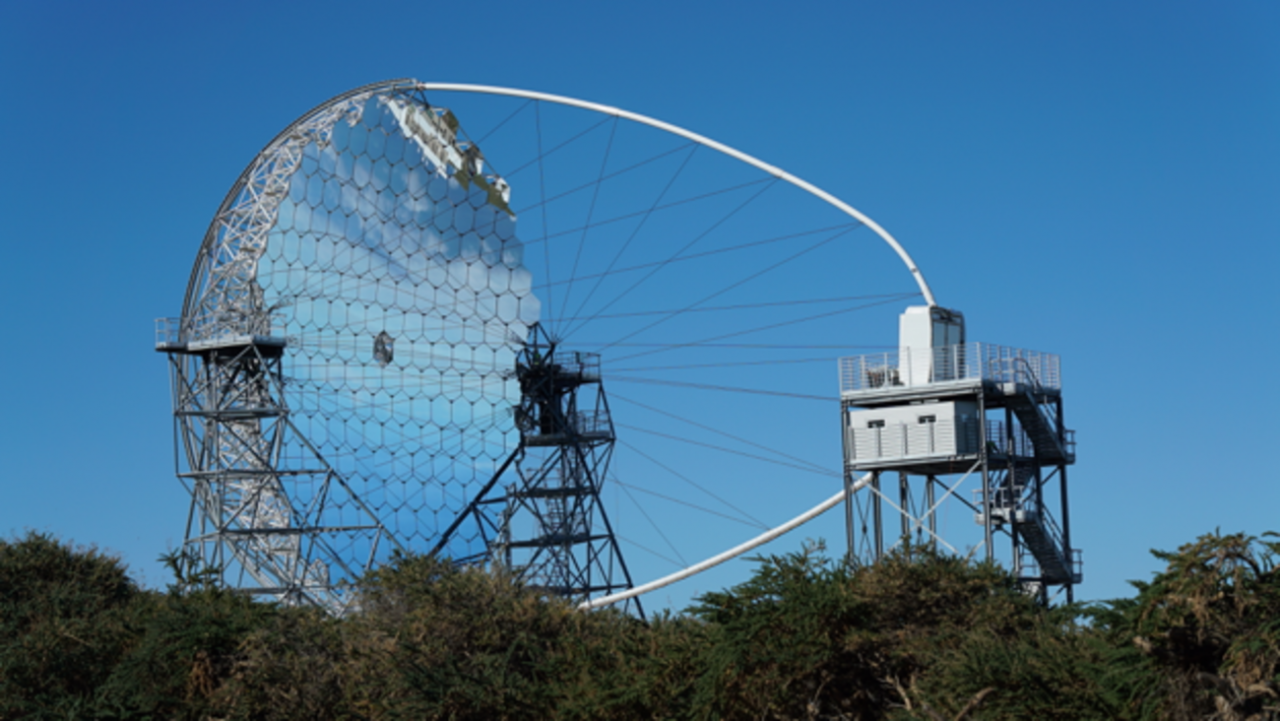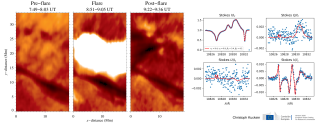Grants related:
General
The MAGIC Collaboration is integrated by 20 research institutes and university departments from Armenia, Bulgaria, Finland, Germany, Italy, Poland, Spain, Switzerland and USA. The collaboration comprises two 17m diameter telescopes, located at the Roque de los Muchachos Observatory, designed to measure the Cherenkov radiation associated with atmospheric showers from very high-energy gamma rays.
CTA is a major international collaboration for building two large Cherenkov observatories at North and South Hemispheres. Roque de los Muchachos Observatory in La Palma has been selected to host the Northern observatory. The first large size telescope was inaugurated in October 2018, and we are presently building the other three.
Members
Results
- Inauguration of the first large-size telescope of CTA (LST-1) at the Observatorio del Roque de Los Muchachos
- Detection of a neutrino generated in a blazar with MAGIC, IcCube and Fermi-LAT
- Discovery of the binary systemPSR J2032+4127/MT91 213 emitting in VHE gamma rays.
Scientific activity
Related publications
-
Monitoring of the radio galaxy M 87 during a low-emission state from 2012 to 2015 with MAGIC
M 87 is one of the closest (z = 0.004 36) extragalactic sources emitting at very high energies (VHE, E > 100 GeV). The aim of this work is to locate the region of the VHE gamma-ray emission and to describe the observed broad-band spectral energy distribution (SED) during the low VHE gamma-ray state. The data from M 87 collected between 2012 and
MAGIC Collaboration et al.Advertised on:
32020 -
Statistics of VHE γ-rays in temporal association with radio giant pulses from the Crab pulsar
Aims: The aim of this study is to search for evidence of a common emission engine between radio giant pulses (GPs) and very-high-energy (VHE, E > 100 GeV) γ-rays from the Crab pulsar. Methods: We performed 16 h of simultaneous observations of the Crab pulsar at 1.4 GHz with the Effelsberg radio telescope and the Westerbork Synthesis Radio Telescope
MAGIC Collaboration et al.Advertised on:
22020 -
Properties of Cosmic Helium Isotopes Measured by the Alpha Magnetic Spectrometer
Precision measurements by the Alpha Magnetic Spectrometer (AMS) on the International Space Station of He 3 and He 4 fluxes are presented. The measurements are based on 100 million He 4 nuclei in the rigidity range from 2.1 to 21 GV and 18 million He 3 from 1.9 to 15 GV collected from May 2011 to November 2017. We observed that the He 3 and He 4
Aguilar, M. et al.Advertised on:
112019 -
Observation of inverse Compton emission from a long γ-ray burst
Long-duration γ-ray bursts (GRBs) originate from ultra-relativistic jets launched from the collapsing cores of dying massive stars. They are characterized by an initial phase of bright and highly variable radiation in the kiloelectronvolt-to-megaelectronvolt band, which is probably produced within the jet and lasts from milliseconds to minutes
Acciari, V. A. et al.Advertised on:
112019 -
Towards Understanding the Origin of Cosmic-Ray Electrons
Precision results on cosmic-ray electrons are presented in the energy range from 0.5 GeV to 1.4 TeV based on 28.1 ×10 6 electrons collected by the Alpha Magnetic Spectrometer on the International Space Station. In the entire energy range the electron and positron spectra have distinctly different magnitudes and energy dependences. The electron flux
Aguilar, M. et al.Advertised on:
32019 -
Towards Understanding the Origin of Cosmic-Ray Positrons
Precision measurements of cosmic ray positrons are presented up to 1 TeV based on 1.9 million positrons collected by the Alpha Magnetic Spectrometer on the International Space Station. The positron flux exhibits complex energy dependence. Its distinctive properties are (a) a significant excess starting from 25.2 ±1.8 GeV compared to the lower
Aguilar, M. et al.Advertised on:
22019 -
Teraelectronvolt emission from the γ-ray burst GRB 190114C
Long-duration γ-ray bursts (GRBs) are the most luminous sources of electromagnetic radiation known in the Universe. They arise from outflows of plasma with velocities near the speed of light that are ejected by newly formed neutron stars or black holes (of stellar mass) at cosmological distances 1,2. Prompt flashes of megaelectronvolt-energy γ-rays
MAGIC Collaboration et al.Advertised on:
112019 -
Testing emission models on the extreme blazar 2WHSP J073326.7+515354 detected at very high energies with the MAGIC telescopes
Extreme high-energy-peaked BL Lac objects (EHBLs) are an emerging class of blazars. Their typical two-hump-structured spectral energy distribution (SED) peaks at higher energies with respect to conventional blazars. Multiwavelength (MWL) observations constrain their synchrotron peak in the medium to hard X-ray band. Their gamma-ray SED peaks above
MAGIC Collaboration et al.Advertised on:
122019 -
Constraints on Gamma-Ray and Neutrino Emission from NGC 1068 with the MAGIC Telescopes
Starburst galaxies and star-forming active galactic nuclei are among the candidate sources thought to contribute appreciably to the extragalactic gamma-ray and neutrino backgrounds. NGC 1068 is the brightest of the star-forming galaxies found to emit gamma-rays from 0.1 to 50 GeV. Precise measurements of the high-energy spectrum are crucial to
Acciari, V. A. et al.Advertised on:
102019 -
The afterglow and kilonova of the short GRB 160821B
GRB 160821B is a short duration gamma-ray burst (GRB) detected and localized by the Neil Gehrels Swift Observatory in the outskirts of a spiral galaxy at z = 0.1613, at a projected physical offset of 16 kpc from the galaxy's center. We present X-ray, optical/nIR, and radio observations of its counterpart and model them with two distinct components
Troja, E. et al.Advertised on:
102019 -
Measurement of the extragalactic background light using MAGIC and Fermi-LAT gamma-ray observations of blazars up to z = 1
We present a measurement of the extragalactic background light (EBL) based on a joint likelihood analysis of 32 gamma-ray spectra for 12 blazars in the redshift range z = 0.03-0.944, obtained by the MAGIC telescopes and Fermi-LAT. The EBL is the part of the diffuse extragalactic radiation spanning the ultraviolet, visible, and infrared bands. Major
Acciari, V. A. et al.Advertised on:
72019 -
Monte Carlo studies for the optimisation of the Cherenkov Telescope Array layout
The Cherenkov Telescope Array (CTA) is the major next-generation observatory for ground-based very-high-energy gamma-ray astronomy. It will improve the sensitivity of current ground-based instruments by a factor of five to twenty, depending on the energy, greatly improving both their angular and energy resolutions over four decades in energy (from
Angüner, E. O. et al.Advertised on:
92019 -
A fast, very-high-energy γ-ray flare from BL Lacertae during a period of multi-wavelength activity in June 2015
The mechanisms producing fast variability of the γ-ray emission in active galactic nuclei (AGNs) are under debate. The MAGIC telescopes detected a fast, very-high-energy (VHE, E > 100 GeV) γ-ray flare from BL Lacertae on 2015 June 15. The flare had a maximum flux of (1.5 ± 0.3) × 10-10 photons cm-2 s-1 and halving time of 26 ± 8 min. The MAGIC
MAGIC Collaboration et al.Advertised on:
32019 -
MAGIC and Fermi-LAT gamma-ray results on unassociated HAWC sources
The HAWC Collaboration released the 2HWC catalogue of TeV sources, in which 19 show no association with any known high-energy (HE; E ≳ 10 GeV) or very-high-energy (VHE; E ≳ 300 GeV) sources. This catalogue motivated follow-up studies by both the Major Atmospheric Gamma-ray Imaging Cherenkov (MAGIC) and Fermi-LAT (Large Area Telescope) observatories
Ahnen, M. L. et al.Advertised on:
52019 -
Observation of Fine Time Structures in the Cosmic Proton and Helium Fluxes with the Alpha Magnetic Spectrometer on the International Space Station
We present the precision measurement from May 2011 to May 2017 (79 Bartels rotations) of the proton fluxes at rigidities from 1 to 60 GV and the helium fluxes from 1.9 to 60 GV based on a total of 1 ×109 events collected with the Alpha Magnetic Spectrometer aboard the International Space Station. This measurement is in solar cycle 24, which has the
Aguilar, M. et al.Advertised on:
82018 -
Observation of Complex Time Structures in the Cosmic-Ray Electron and Positron Fluxes with the Alpha Magnetic Spectrometer on the International Space Station
We present high-statistics, precision measurements of the detailed time and energy dependence of the primary cosmic-ray electron flux and positron flux over 79 Bartels rotations from May 2011 to May 2017 in the energy range from 1 to 50 GeV. For the first time, the charge-sign dependent modulation during solar maximum has been investigated in
Aguilar, M. et al.Advertised on:
82018 -
Precision Measurement of Cosmic-Ray Nitrogen and its Primary and Secondary Components with the Alpha Magnetic Spectrometer on the International Space Station
A precision measurement of the nitrogen flux with rigidity (momentum per unit charge) from 2.2 GV to 3.3 TV based on 2.2 ×106 events is presented. The detailed rigidity dependence of the nitrogen flux spectral index is presented for the first time. The spectral index rapidly hardens at high rigidities and becomes identical to the spectral indices
Aguilar, M. et al.Advertised on:
82018 -
Multimessenger observations of a flaring blazar coincident with high-energy neutrino IceCube-170922A
Previous detections of individual astrophysical sources of neutrinos are limited to the Sun and the supernova 1987A, whereas the origins of the diffuse flux of high-energy cosmic neutrinos remain unidentified. On 22 September 2017, we detected a high-energy neutrino, IceCube-170922A, with an energy of ~290 tera-electron volts. Its arrival direction
IceCube Collaboration et al.Advertised on:
72018 -
Observation of New Properties of Secondary Cosmic Rays Lithium, Beryllium, and Boron by the Alpha Magnetic Spectrometer on the International Space Station
We report on the observation of new properties of secondary cosmic rays Li, Be, and B measured in the rigidity (momentum per unit charge) range 1.9 GV to 3.3 TV with a total of 5.4 ×106 nuclei collected by AMS during the first five years of operation aboard the International Space Station. The Li and B fluxes have an identical rigidity dependence
Aguilar, M. et al.Advertised on:
12018 -
Deep observations of the globular cluster M15 with the MAGIC telescopes
A population of globular clusters (GCs) has been recently established by the Fermi-LAT telescope as a new class of GeV γ-ray sources. Leptons accelerated to TeV energies, in the inner magnetospheres of MSPs or in their wind regions, should produce γ-rays through the inverse Compton scattering in the dense radiation field from the huge population of
Bhattacharyya, W. et al.Advertised on:
42019



